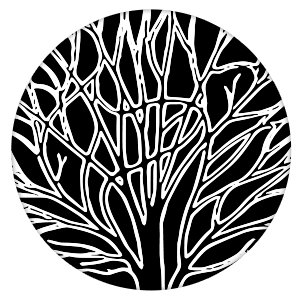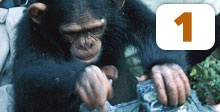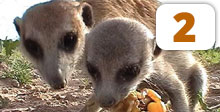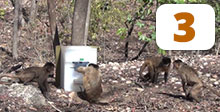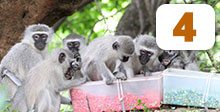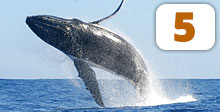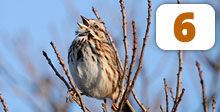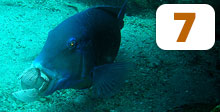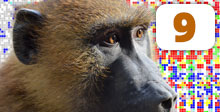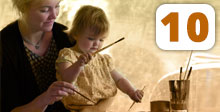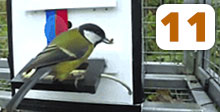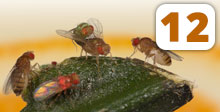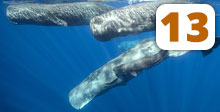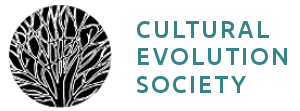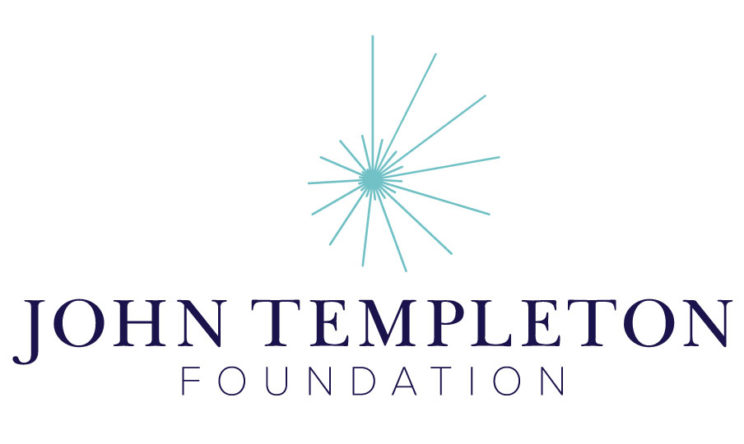Animal Cultures: Core Discoveries and New Horizons
Reading lists
Readings are listed by lecture for the whole module.
Introductory Overview (Andy Whiten)
Core (testable) readings
Whiten, A. (2017) A second inheritance system: The extension of biology through culture. Royal Society Interface Focus 7, 20160142.
The most recent concise review of evidence for culture across the animal kingdom, and its implications for evolutionary biology at large.
Galef, B.G. (2012) Social learning and traditions in animals: evidence, definitions, and relationship to human culture. Wiley Interdisciplinary Reviews – Cognitive Science 3, 581-592.
Galef has been one of the most prolific and influential authors in animal social learning research, and as a committed lab experimentalist, often a critic of less controlled studies from the wild. This paper offers his appraisal of the field after a lifetime’s personal contributions to the field.
Further reading
Laland, K.N. & Galef, B.G. (2009) The Question of Animal Culture. Harvard University Press.
Contains a dozen chapters by authors chosen to represent a substantial diversity of conclusions on the existence and nature of animal culture. Of course much has been discovered in the decade since which may change opinions expressed in this book, but at present it remains perhaps the best way to appreciate the breadth of scientific approaches and orientations in the field, written by several of its most influential figures – although it is a manifestly mammal-centric collection.
Social learning processes (Alex Thornton)
Core (testable) readings
Hoppitt, W. and Laland, K.N., 2008. Social processes influencing learning in animals: a review of the evidence. Advances in the Study of Behavior, 38, pp.105-165
A comprehensive review of the processes through which animals may learn from each other, considering defnitions and empirical evidence.
Thornton, A. and Raihani, N.J., 2008. The evolution of teaching. Animal behaviour, 75, 1823-1836.
A review of the evidence for teaching in non-human animals, providing a framework to think about what teaching is and why it evolves.
Further reading
Aplin, L.M., 2019. Culture and cultural evolution in birds: a review of the evidence. Animal behaviour, 147, pp.179-187.
Thornton, A. and Clutton-Brock, T., 2011. Social learning and the development of individual and group behaviour in mammal societies. Philosophical Transactions of the Royal Society B: Biological Sciences, 366, 978-987.
Much of the literature focuses on primates, but there is extensive evidence that social learning processes shape the development of both individual and group behaviour in many other animals. These two papers consider evidence from birds and mammals.
Social learning strategies (Rachel Kendall)
Core (testable) readings
Kendal, R. et al. 2018. Social learning strategies: Bridge-building between fields. Trends in Cognitive Sciences 22: 651-665
The most recent review of evidence for social learning strategies and discussion of mechanisms underlying social learning strategies.
Rendell, L. et al. 2011. Cognitive culture: theoretical and empirical insights into social learning strategies. Trends in Cognitive Sciences 15: 68-76
A concise summary of the theory behind social learning strategies and associated experiments.
Further reading
Kendal, R. et al. 2005. Trade-offs in the adaptive use of social and asocial learning. Advances in the Study of Behaviour 35: 333-379
An early in depth investigation of theory in relation to social learning strategies and the empirical evidence available at the time. And see the many studies cited on the slides for further reading related to evidence of specific social learning strategies
Major study groups – Primates and other terrestrial mammals (Erica van de Waal)
Core (testable) readings
Watson, S. K., Botting, J., Whiten, A., & van de Waal, E. (2018). Culture and Selective Social Learning in Wild and Captive Primates. In Evolution of Primate Social Cognition (pp. 211-230). Springer, Cham.
A concise review on culture and social learning in primates, in both captive and wild settings
Whiten, A., & van de Waal, E. (2018). The pervasive role of social learning in primate lifetime development. Behavioral ecology and sociobiology, 72(5), 80.
A recent review of the importance of social learning in primates throughout the different life stages.
Further reading
Schuppli, C., & van Schaik, C. P. (2019). Animal cultures: how we’ve only seen the tip of the iceberg. Evolutionary Human Sciences, 1
A controversial new empirical approach to estimating the scope of ape cultural repertoires.
Galef, Bennett G., and Elain E. Whiskin. “‘Conformity’ in Norway rats?.” Animal Behaviour 75.6 (2008): 2035-2039.
Experiments on rats, challenging primatologists’ approach to conformity.
Bono, A. E., Whiten, A., van Schaik, C., Krützen, M., Eichenberger, F., Schnider, A., & van de Waal, E. (2018). Payoff-and sex-biased social learning interact in a wild primate population. Current Biology, 28(17), 2800-2805.
Field experiments showing the scope of social learning in natural social groups.
Major study groups – Whales and dolphins (Luke Rendell)
Core (testable) readings
Cantor, M., & Whitehead, H. (2013). The interplay between social networks and culture: theoretically and among whales and dolphins. Philosophical Transactions of the Royal Society B 368.
How social structure and culture interact in whales and dolphins, and more generally.
Sargeant, B.L., & Mann, J. (2009). From social learning to culture: intrapopulation variation in bottlenose dolphins. In The Question of Animal Culture, (pp. 152– 73). Harvard University Press, Cambridge, MA.
Diverse cultures of the particularly well-studied Shark Bay bottlenose dolphins.
Further reading
Whitehead, H. & Rendell, L. (2015). The Cultural Lives of Whales and Dolphins. Chicago: Chicago University Press.
The most recent and comprehensive review of the topic.
McDonald, M.A., Hildebrand, J.A., & Mesnick, S. (2009). Worldwide decline in tonal frequencies of blue whale songs. Endangered Species Research 9,13– 21.
Perhaps of the most extraordinary discovery in the study of animal cultures.
Major study groups – Birds (Lucy Aplin)
Core (testable) readings
Aplin, L.M., 2019. Culture and cultural evolution in birds: a review of the evidence. Animal Behaviour, 147, pp.179-187.
A recent review of the evidence for culture and cultural evolution in birds across multiple behavioural domains.
Beecher, M. D., & Brenowitz, E. A. (2005). Functional aspects of song learning in songbirds. Trends in ecology & evolution, 20(3), 143-149.
A comprehensive guide to the evolution and ecology of song learning in birds, including a critical review of the current state of knowledge.
Further reading
Aplin, L. M., Farine, D. R., Morand-Ferron, J., Cockburn, A., Thornton, A., & Sheldon, B. C. (2015). Experimentally induced innovations lead to persistent culture via conformity in wild birds. Nature, 518(7540), 538.
An experimental study of the spread of innovation and establishment of culture in a wild bird population.
Slagsvold, Tore, and Karen L. Wiebe. “Social learning in birds and its role in shaping a foraging niche.” Philosophical Transactions of the Royal Society B: Biological Sciences 366.1567 (2011): 969-977.
This paper is both a review of social learning in foraging behaviour and an experimental study using cross fostering to examine the role of cultural inheritance in shaping behaviour in three sympatric bird species.
Wright, T. F., & Dahlin, C. R. (2018). Vocal dialects in parrots: patterns and processes of cultural evolution. Emu-Austral Ornithology, 118(1), 50-66.
A review of the evidence for dialects in social calls of parrot species, and a discussion of the interplay between ecology, social dynamics and vocal learning.
Major study groups – Fish (Culum Brown)
Core (testable) readings
Brown, C. & Laland, K. N. (2011). Social learning in fishes. In: Fish Cognition and Behaviour 2nd Edition (Brown, C., Laland K. & Krause, J. eds). Blackwell Publishing, Cambridge, UK.
A review of social learning in fishes.
Brown, C. & Laland, K (2001) Social learning and life skills training for hatchery reared fish. Journal of Fish Biology 59 (3), 471-493.
A review of fisheries applications of social learning theory.
Further reading
See the many studies cited on the slides for further reading related to evidence of social learning and culture in fishes.
Major study groups – Insects (Étienne Danchin)
Core (testable) readings
Alem, S., Perry, C.J., Zhu, X., Loukola, O.J., Ingraham, T., Søvik, E. & Chittka, L. (2016) Associative Mechanisms Allow for Social Learning and Cultural Transmission of String Pulling in an Insect. PLoS Biology 14, e1002564.
Danchin, É., Nöbel, S., Pocheville, A., Dagaeff, A.-C., Demay, L., Alphand, M., Ranty-Roby, S., Van Renssen, L., Monier, M., Gazagne, É., Allain, M. & Isabel, G. (2018) Cultural flies: conformist social learning in fruit flies predicts long-lasting mate-choice traditions. Science 362, 1025-1030.
Further reading
Avital, E. & Jablonka, E. (2000) Animal Traditions. Behavioural Inheritance in Evolution. Cambridge University Press, Cambridge.
Von Frisch, Karl, and Leigh E. Chadwick. (1967).The dance language and orientation of bees. Vol. 1. Cambridge, MA: Belknap Press of Harvard University Press.
Cumulative cultural evolution in animals? (Nicolas Claidière)
Core (testable) readings
Mesoudi, A., & Thornton, A. (2018). What is cumulative cultural evolution? Proceedings of the Royal Society B: Biological Sciences, 285(1880). doi:10.1098/rspb.2018.0712
Discusses a core set of criteria to assess the presence of CCE in animals as well as reviewing the evidence.
Sasaki, T., & Biro, D. (2017). Cumulative culture can emerge from collective intelligence in animal groups. Nature Communications, 8(1), 15049. doi:10.1038/ncomms15049
A clear and comprehensive study showing progressive improvement of flying routes in pigeons.
Further reading
Tomasello, M., Kruger, A. C., & Ratner, H. H. (1993). Cultural learning. Behavioral and Brain Sciences 16, 495-552.
The paper that sparked the modern interest in CCE comparing human and non-human social learning (imitation) and suggesting that fidelity is at the origin of the ratchet effect in humans.
Claidière, N., Smith, K., Kirby, S., & Fagot, J. (2014). Cultural evolution of systematically structured behaviour in a non-human primate. Proceedings of the Royal Society B: Biological Sciences, 281, 1797. doi:10.1098/rspb.2014.1541
This experimental paper shows how cultural evolution can lead to the emergence of complex behaviours typical of human cultural evolution.
Whiten, A. (2019). Cultural Evolution in Animals. Annual Review of Ecology, Evolution, and Systematics, 50(1), 27-48. doi:10.1146/annurev-ecolsys-110218-025040
For a wider perspective on cultural evolution in general.
Implications for the evolution of human culture (Andy Whiten)
Core (testable) readings
Whiten, A. (2011). The scope of culture in chimpanzees, humans and ancestral apes. Philosophical Transactions of the Royal Society B: Biological Sciences 366, 997-1007.
Reviews aspects of culture shared by human and non-human apes, particularly chimpanzees, to draw inferences about the ancestral cultures of this group.
Tennie C, Call J, Tomasello M (2009) Ratchetting up the ratchet: on the evolution of cumulative culture. Philosophical Transactions of the Royal Society B: Biological Sciences 364 2405-2415.
Updates core propositions of the 1993 Tomasello et al. BBS paper on Cultural Learning in the light of further evidence, arguing that humans are the only species to display the ratchet-like process of cumulative culture, and suggesting why.
Further reading
Whiten, A. (2017). Social learning and culture in child and chimpanzee. Annual Review of Psychology, 68, 129-154.
Updates evidence concerning the comparisons underlying Whiten (2011) above
Implications for ecology and evolution (Lucy Aplin)
Core (testable) readings
Beans, C. (2017). News Feature: Can animal culture drive evolution?. Proceedings of the National Academy of Sciences, 114(30), 7734-7737.
A popular science article arguing that advances in animal culture research may have major implications for evolutionary ecology.
Aplin, L. (2016). Understanding the multiple factors governing social learning and the diffusion of innovations. Current opinion in behavioral sciences, 12, 59-65.
A concise summary of the ecological contexts and trade-offs determining the use of social learning, and a discussion of the factors underlying the spread and emergence of new cultures.
Whiten, A. (2017). Culture extends the scope of evolutionary biology in the great apes. Proceedings of the National Academy of Sciences, 114(30), 7790-7797.
A discussion of the pervasive importance of culture to the ecology and evolution of primates, and an introduction to the research methods and approaches that are beginning to reveal the scope of this role.
Further reading
Koops, K., Visalberghi, E., & van Schaik, C. P. (2014). The ecology of primate material culture. Biology Letters, 10(11), 20140508.
A review of the evidence for the role of ecology in shaping material culture in three primate species, and a discussion of the role of necessity vs opportunity in driving the expression and patterning of cultural traits.
Slabbekoorn, H., & Smith, T. B. (2002). Bird song, ecology and speciation. Philosophical Transactions of the Royal Society of London. Series B: Biological Sciences, 357(1420), 493-503.
A classic review of the role of bird song and vocal learning on reproductive divergence and speciation in passerine birds. The start of an integrative approach considering the role of song culture in tandem with ecology over the process of speciation.
Whitehead, H. (2017). Gene–culture coevolution in whales and dolphins. Proceedings of the National Academy of Sciences, 114(30), 7814-7821.
An ambitious and persuasive argument for the role of culture in shaping genetic diversity in whales.
Implications for evolutionary biology (Étienne Danchin)
Core (testable) readings
Bentley, R.A., Hahn, M.W. & Shennan, S.J. (2004). Random drift and culture change. Proceedings of the Royal Society of London B 271, S353-S356.
Danchin, É., Pocheville, A. & Huneman, P. (2019). Early in life effects and heredity: reconciling neo-Darwinism with neo-Lamarckism under the banner of the inclusive evolutionary synthesis. Philosophical Transactions of the Royal Society B-Biological Sciences 374, 20180113.
Further reading
Danchin, É., Charmantier, A., Champagne, F.A., Mesoudi, A., Pujol, B. & Blanchet, S. (2011). Beyond DNA: integrating inclusive inheritance into an extended theory of evolution. Nature Reviews Genetics 12, 475-486.
Jablonka, E. & Lamb, M.J. (2005). Evolution in four dimensions. Genetic, Epigenetic, Behavioural, and Symbolic Variation in the history of life. MIT Press, Cambridge Massachusetts.
Implications for conservation and welfare (Hal Whitehead)
Core (testable) readings
Greggor, A.L., Thornton, A. & Clayton, N.S. (2017). Harnessing learning biases is essential for applying social learning in conservation. Behavioral Ecology and Sociobiology, 71, 16.
This paper considers how social learning and, in particular, biases in the way animals learn from one another affect their conservation status and attempts to improve that status.
Whitehead, H. (2010). Conserving and managing animals that learn socially and share cultures. Learning and Behavior, 38, 329-336.
A review of how animal cultures interact with the theory and practice of conservation biology.
Further reading
Brakes, P., Dall, S.R.X., Aplin, L.M., Bearhop, S., Carroll, E.L., Ciucci, P. et al. (2019). Animal cultures matter for conservation. Science, 363, 1032-1034.
After a brief, but current, review of the significance of animal cultures in conservation biology, this paper highlights the potentially important role of international legal instruments, such as the Convention on Migratory Species, in this area.
Ryan, S.J. (2006). The role of culture in conservation planning for small or endangered populations. Conservation Biology, 20, 1321-1324.
This paper addresses the role of animal culture in delineating population segments for conservation purposes, introducing the concept of Culturally Significant Units.
This project was supported by Grant #61105 from the John Templeton Foundation to the University of Tennessee, Knoxville (PIs: S. Gavrilets and P. J. Richerson) with assistance from the Center for the Dynamics of Social Complexity and the National Institute for Mathematical and Biological Synthesis at the University of Tennessee, Knoxville.

The Cultural Evolution Society's Online Learning Tutorial Series is licensed under a Creative Commons Attribution-NonCommercial-ShareAlike 4.0 International License. For designers' contact information, click here.
